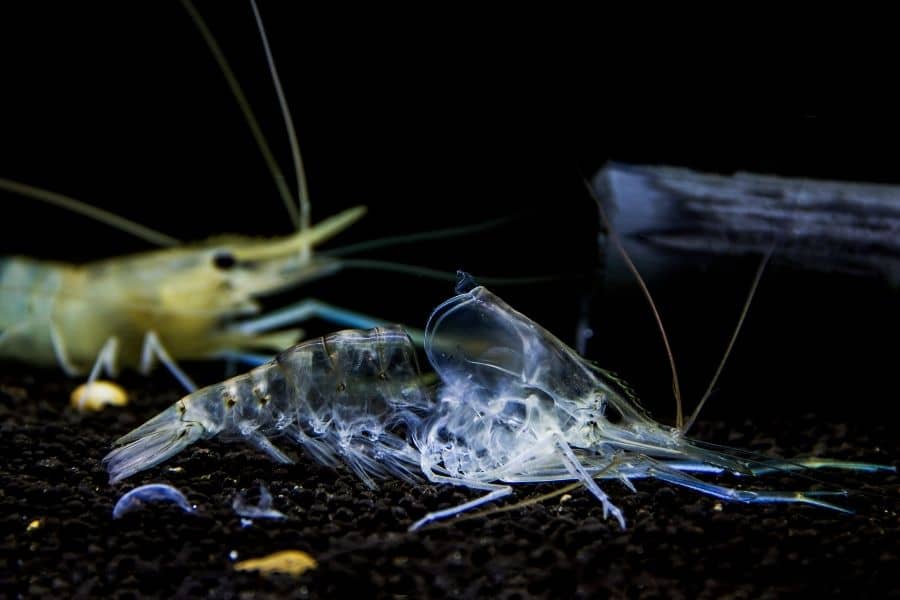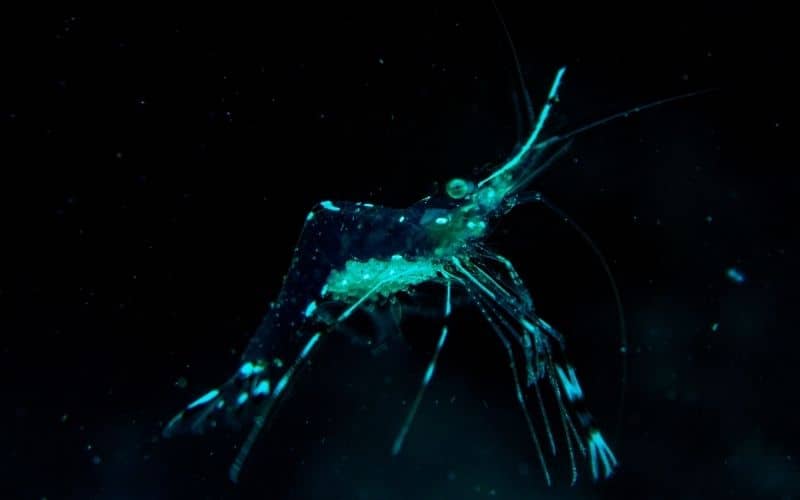Ghost shrimp or glass shrimp is a famous shrimp variety among fish lovers. They add extra beauty to your tank. But no matter what type of shrimp you have, you need to know the molting process. This article will give you a better idea about it. Molting is a process by which shrimps leave their tight-fitting exoskeleton to grow a new and large exoskeleton. Because once shrimps outgrow their existing exoskeleton, shrimps have to shed or molt. This molting process helps to develop a new one. This is the most common reason for Ghost Shrimp Turning White
How often do ghost shrimp shed ? The lifespan of ghost shrimp is as short as a year. They have a rapid growth rate during the year. Molting or shed can happen a lot of times throughout the year. Healthy adult shrimp will molt or shed their exoskeleton every 3 to 4 weeks. But this varies with young shrimps. So young shrimps will often shed or molt more due to their rapid growth. Perhaps it will happen every 1 or 2 weeks.

I know you are here because your shrimp is looking ward. let’s dive deeper into this molting process
Shedding or molting is varying according to the growth rate of shrimp.
Jump To
- 1 Shedding or molting is varying according to the growth rate of shrimp.
- 2 How do you know when ghost shrimp are molting?
- 3 How long does it take ghost shrimp to molt
- 4 Is shrimp molting a good sign?
- 5 Ghost shrimp molting or dying?
- 6 How long do shrimp hide after molting
- 7 Can shrimp die from molting?
- 8 Should you remove molts?
- 9 Ghost Shrimp Turning White
- Larva stage – can molt almost every day
- Post-larvae stage – 20% – can molt every 3-4 days
- Juvenile (Subadults) -7% – can molt every 4-10 days
- Adult dwarf shrimp – can molt in general every 1-1,5 months. Adult shrimps molt with only the purpose of regenerating lost limbs.
Shrimps are invertebrates, and they have exoskeletons to protect themselves.
It is a skeleton on the outside of the shrimp’s body. About 5% of the body weight of prawns is the exoskeleton. The exoskeleton has built with three main components and other additional things.
- Chitin (20-30 %)
- Proteins (30-40%)
- Calcium carbonate (30-50%)
- Pigments (astaxanthin, canthaxanthin, lutein, or β-carotene)
How do you know when ghost shrimp are molting?
You can identify when ghost shrimps are ready to molt through a few signals in the behaviors of shrimps.
The most common sign is that shrimps stay still for a long time, and they do not move far for an hour or more, they will try to hide around plants and Ghost Shrimp Turning White in some cases.
When this is done, sometimes shrimps may not even eat. They will remain motionless, but their antenna will move slightly.
But if you see a large number of ghost shrimps behaving this way, it could be a problem with the water parameters, and you should check and adjust as needed. But if there are only a very small number of ghost shrimps standing, you can come back in a few hours and see a new mold.
How long does it take ghost shrimp to molt
Did you see the molting of your shrimp? It happens quickly. The ghost shrimp’s molting process happens very fast, and it just takes no more than 10 – 15 minutes. Normally ghost shrimp molt before mating. Because this time female shrimp has soft and flexible cuticles. But molting happens rapidly and during this small-time male shrimp have to find the hidden female and mate.
Read More Do Amano Shrimp Eat Algae? 14 Things You Should Know
Is shrimp molting a good sign?
Yes, shrimp molting is a good sign. Because molting happens when shrimp is growing. Therefore, molting is good evidence to prove shrimp growth. That is to say; shrimp are invertebrates. Therefore, shrimps have to build exoskeletons to protect themselves. But when shrimps grow gradually, ghost shrimp molt their current exoskeleton and allow them to grow a new one. Also, the breeding behavior of shrimp begins after the female molts.
They release into the water. This chemical substance gives a signal to male shrimps that she is ready to mate. The “smell” attracts males and allows them to find certain female shrimp in the water column. Sexually mature male shrimps swim around the tank and try to find the newly molted, hiding female.
After shedding or molting, ghost shrimps are very soft and vulnerable. Therefore, they will hide for a few days until they have a chance to re-tighten their outer shell. You can promote ghost shrimp molt by changing the water. On average, a 20% water change for an aquarium will give your shrimp shells a chance to molt.
If you accidentally change the water while adding new shrimp to your aquarium. It can be bad for your shrimp. Also, nutrition, water quality, water temperature, shrimp age or size, and shrimp sex are the important factors that affect the molt frequency to a varying degree.
Ghost shrimp molting or dying?
Shrimp is living in a shell because it is invertebrates. When shrimp grows gradually, it cannot live in this shell anymore. Because of this, the shrimp has to change its shell and allow it to grow a new exoskeleton. Therefore, molting is an important and essential process for your shrimp to live. Molting happens a lot throughout the lifespan of shrimp. If your shrimp is standing motionless or a shell is floating around, do not worry. Most probably your shrimp molted.
But when shrimp molt, someone can think it died because they stand still for a long time without much movement. When a shrimp dies, it initially resides at the bottom of the tank, and when the shrimp carcasses begin to decompose, the shrimp’s body begins to float in the water.
These are the reasons that cause this misunderstanding. Therefore, you need to know how to identify a dead shrimp.
When comparing other fish, shrimps are very sensitive. Because of that, many things lead to shrimp death. However, shrimps are very active fish, and you can see shrimps are always moving in the water. When they die, they fall to the bottom of the tank. But this may not happen in always. However, you can easily identify the dead shrimp because the dead shrimp changes its color to pink.
How long do shrimp hide after molting
If you have shrimps, you have seen their exoskeleton, which is the shell of shrimp. Through molting, process shrimps change their shells according to their growth rate. After molting shrimps, surely you cannot see your shrimps in the tank easily. Shrimps tend to hide after molting for 48-72 hours because their new skin is relatively soft and smooth. The skin is also relatively vulnerable because they have risks for open up to diseases and other hazards. Through the time that they are hidden, they have been able to tighten their shell.

Can shrimp die from molting?
Yes. Shrimps can die from molting due to a few issues. The most common molting issue is the “White Ring of Death”. The white ring of death can be identified as a clear white line around the shrimp’s body behind the point where the head separates from the body.
As the shrimp grow to the size and break its current outer bone, it must split above the back of the head, allowing the head and body to bend through the gap and jump out quickly. Abandons its old shell. This is where the issue of white ring death can be seen. The white ring of death occurs when the shell breaks all over the body instead of just at the top and exposes their clear/white body parts.
Essentially, the shrimp has two disconnected exoskeletons that make it more difficult to bend and jump out. As a result, they can get stuck in their mold, become stressed, and die within a few days. There are many causes of the white ring of death. One is water changes. Therefore, we need to highly consider the parameters of the freshwater such as KH, GH, pH, and TDS.
You should maintain a healthy range of these parameters for your shrimp. If everything seems right, look for nutrients in their diet. Because shrimp’s unbalanced diet also causes this issue. Another issue that causes the death of shrimp during molting is “stuck in molt”. If you see your shrimp lying on its side motionless and constantly twitching, it is a sign your shrimp is trying to molt, but somehow, it sticks, unfortunately.
This is because their shell is broken in the wrong place, and now they cannot come from their old exoskeleton. Unfortunately, in this situation, you are not able to help your shrimp. The shrimp will eventually have a chance to get rid of the molt, but this will not always be successful. Some fish keepers try to remove the old exoskeleton by using tweezers with the purpose of saving the life of shrimp. But it is not always possible.
Should you remove molts?
No. It does not need to remove from your tank. This exoskeleton has more minerals which help to build up new shells for shrimps. Therefore, shrimps eat molts happily and do not worry about the smell because the molts do not make an unnecessary mess. But keep in mind, there are some cases where you should remove the molts.
If your shrimp is sick, you should remove the molts. Since parasitic eggs or bacteria remain in the shell, it is unwise to keep the source of these problems in the tank after the parasite or bacterial infection.
Ghost Shrimp Turning White
The most common reason that Ghost Shrimp Turning White is
- Ghost Shrimp is ready to molt
- Due to old age
- Bad health condition
- Water quality problems
The above 4 factors are the main causes of Ghost Shrimp Turning White. If this is caused due to molting you do not need to worry about that. But you need to examine all factors.
Ghost Shrimp have a two-year lifespan, so if you bought them as adults, you might have a shrimp that is nearing the end of its natural existence so it can turn white. Although this is unfortunate for you as the pet owner, it is a basic fact of life, and it ensures you provided your shrimp with the best possible life.
Read More Amano shrimp vs. Ghost shrimp 7 Differences
SOURCE
Settlement cues in an Atlantic coast population of the ghost shrimp
